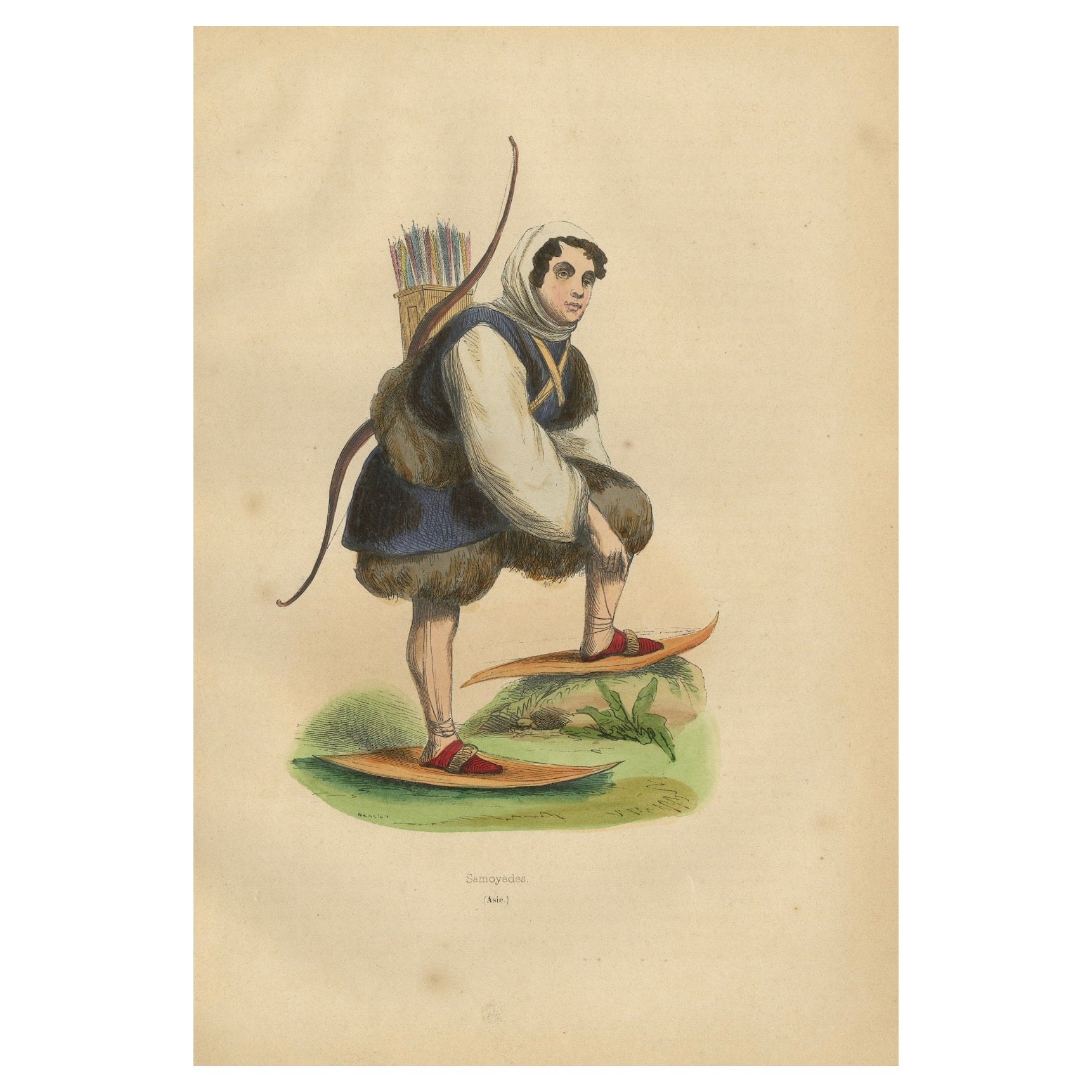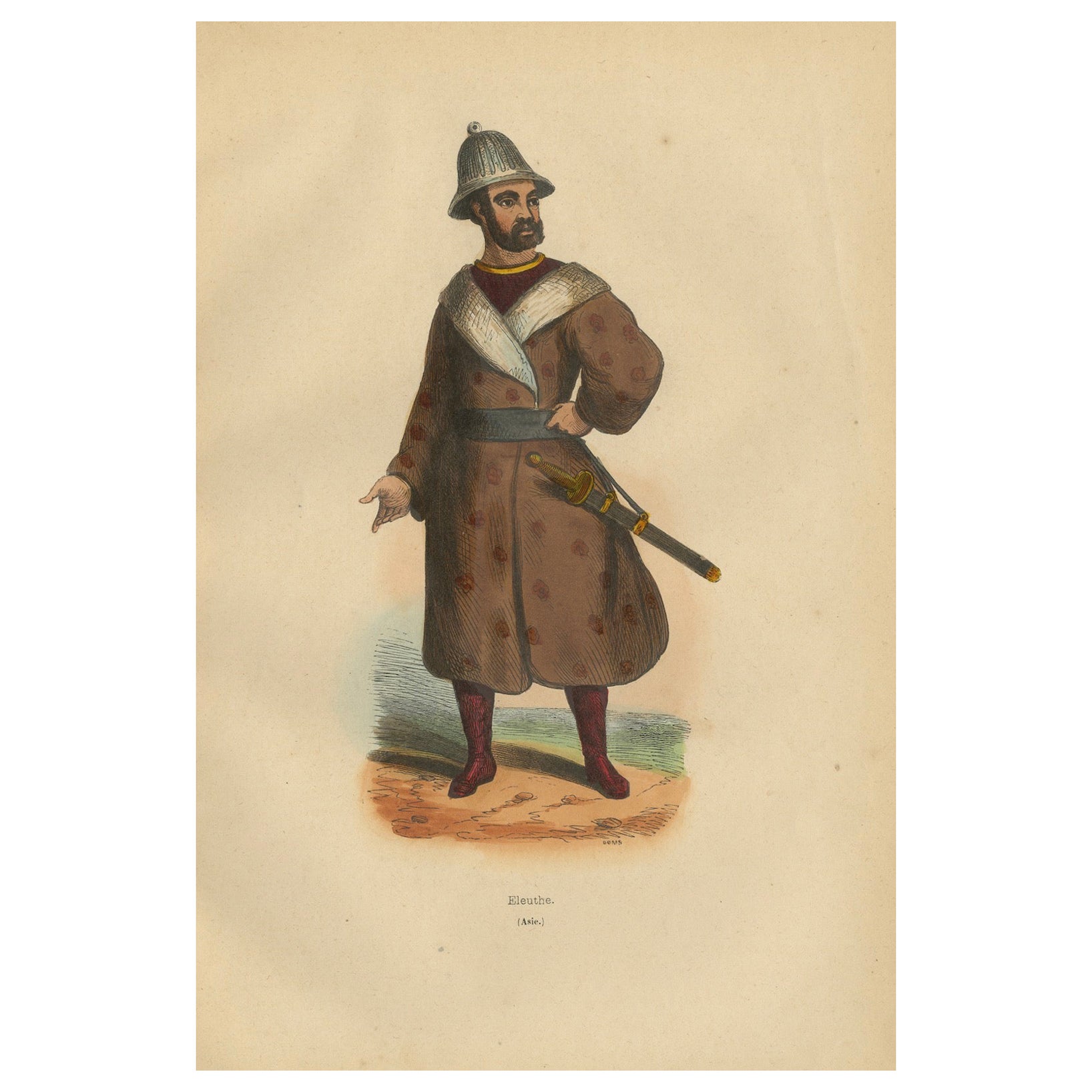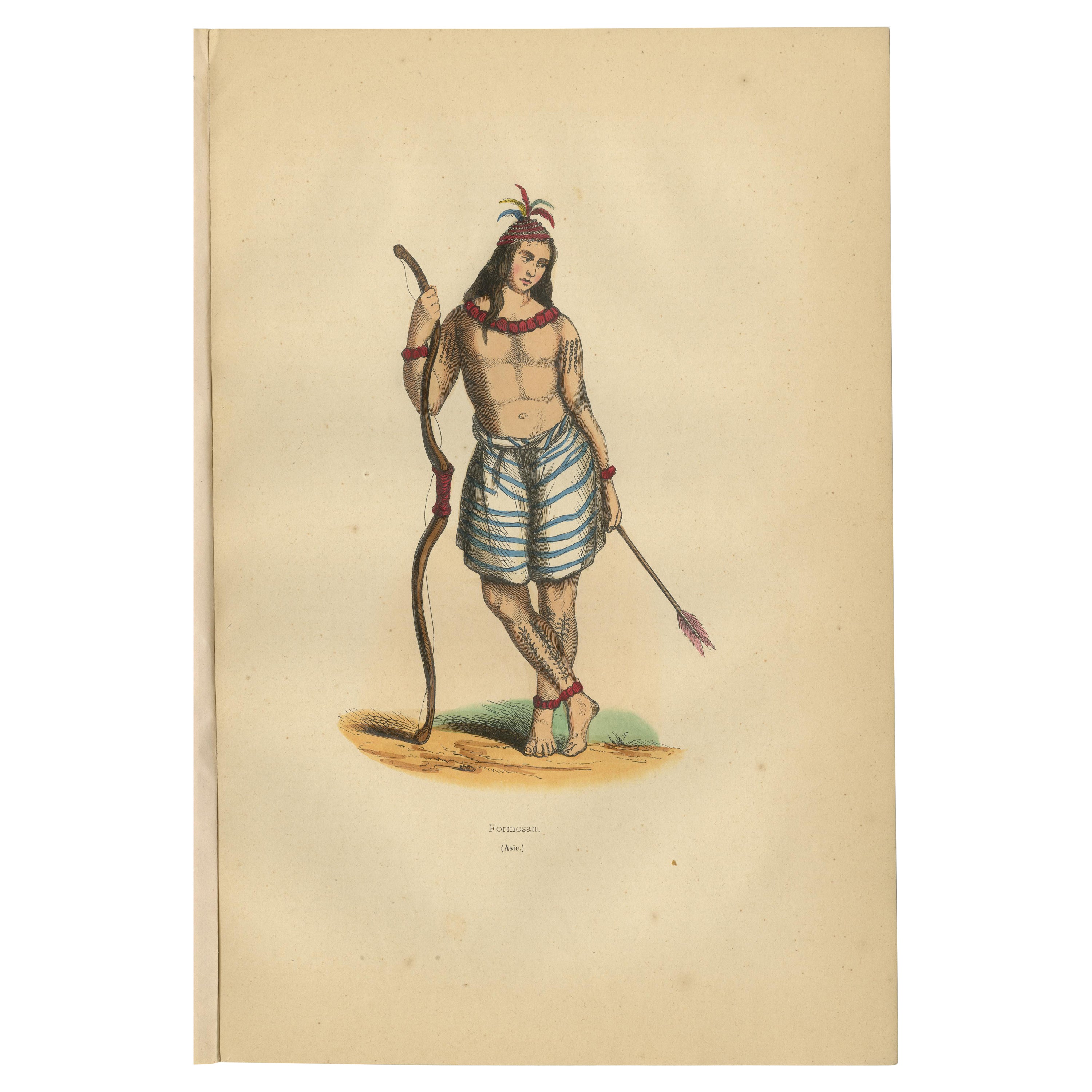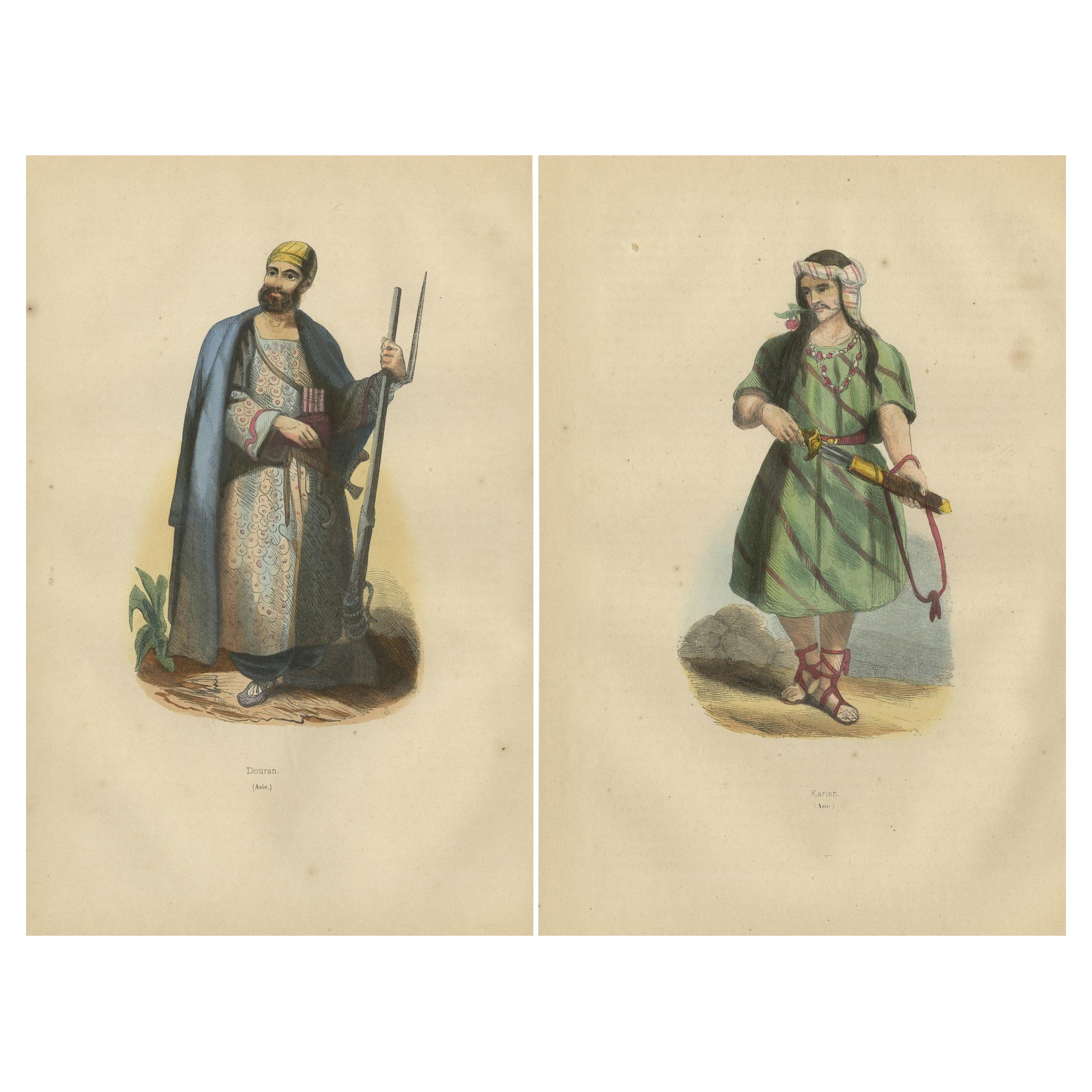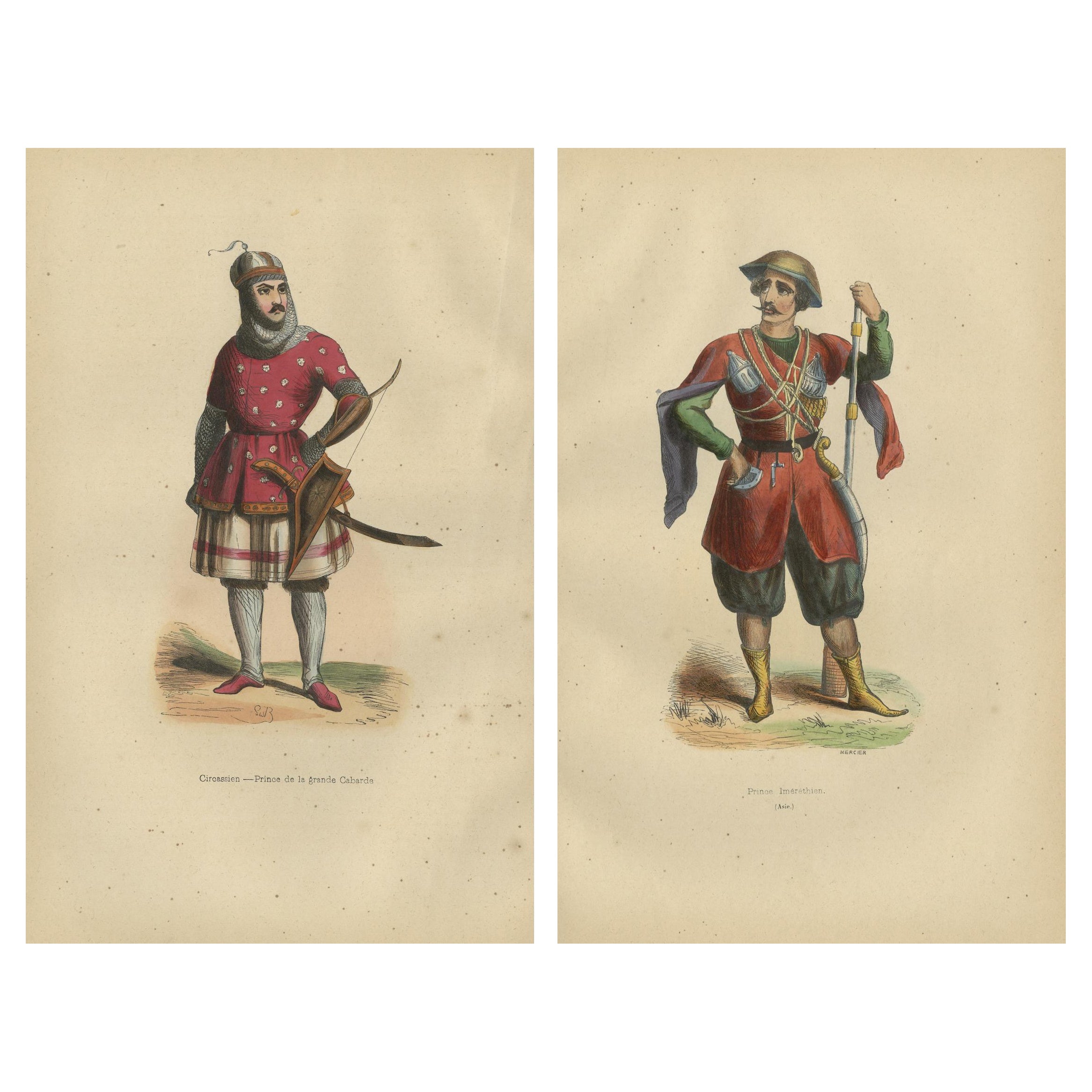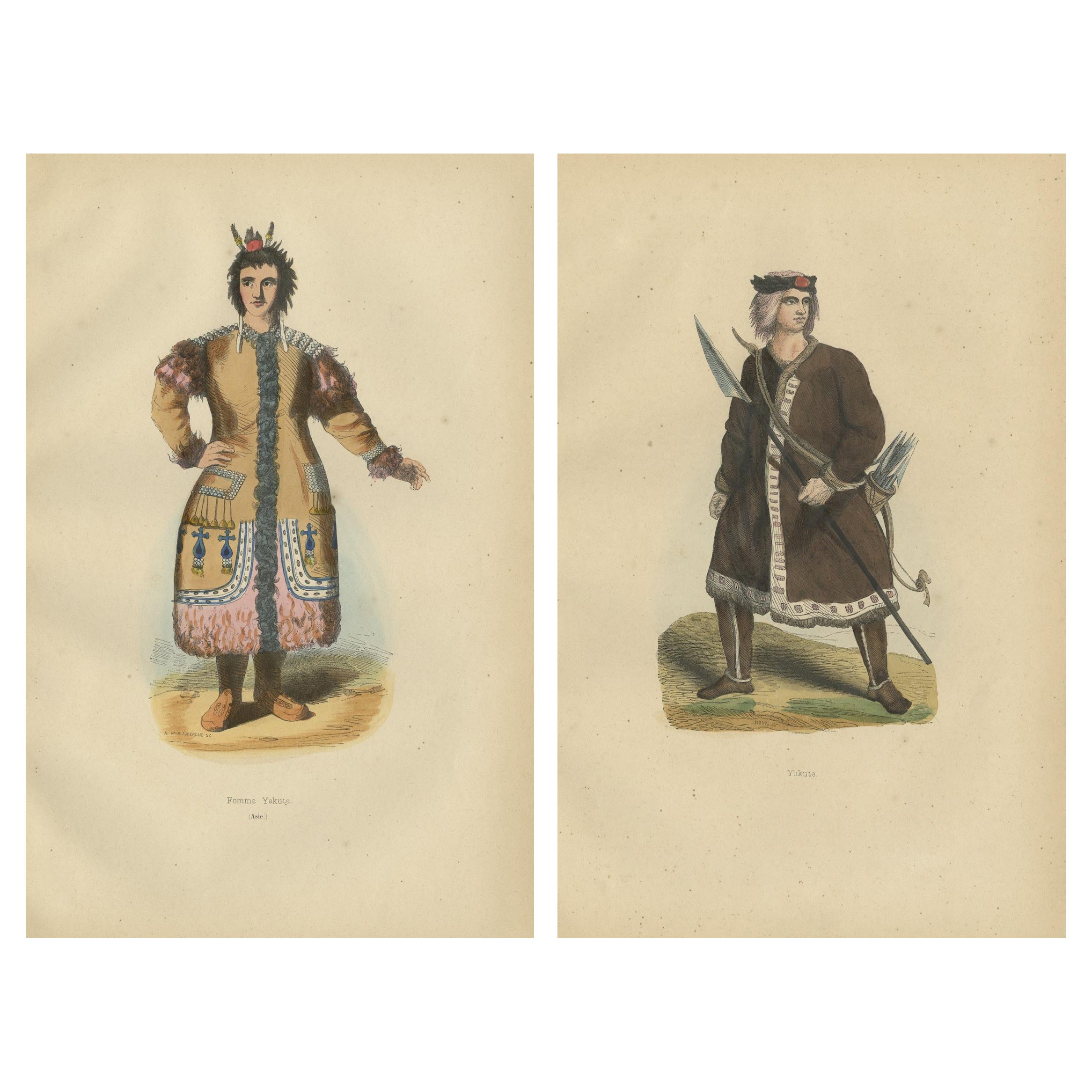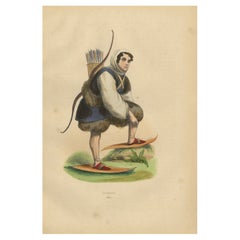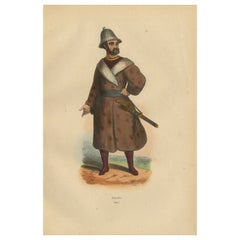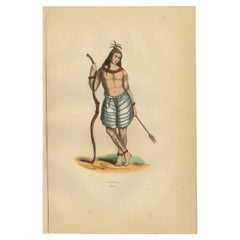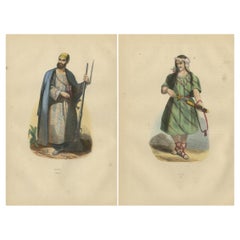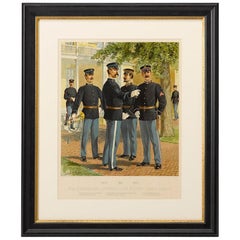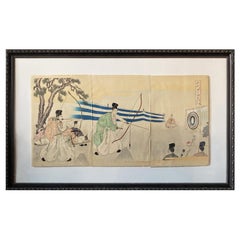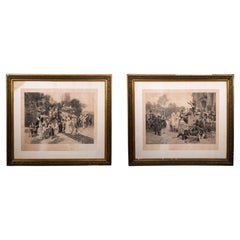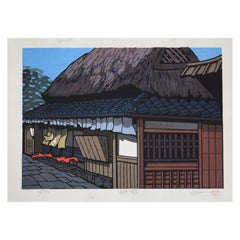Items Similar to Traditional Archery and Infantry Gear: Kyrgyz and Kalmyk Warriors in 1844
Want more images or videos?
Request additional images or videos from the seller
1 of 8
Traditional Archery and Infantry Gear: Kyrgyz and Kalmyk Warriors in 1844
About the Item
Traditional Archery and Infantry Gear: Kirghiz and Kalmouk Warriors in 1844
The two tribesmen depicted in the prints are from distinct ethnic groups:
1. Kirghiz - The individual labeled "Kirghiz" is likely from the Kyrgyz people, a Turkic ethnic group primarily found in Kyrgyzstan in Central Asia. Historically, the Kyrgyz have been known for their nomadic lifestyle, predominantly involving pastoralism, living in mountainous regions of Central Asia. Their traditional attire, as depicted in the lithograph, often includes robust and practical elements suited for a life of movement across varied terrains.
2. Kalmouk - The man labeled "Kalmouk" represents the Kalmyk people, who are of Mongolian descent and live primarily in the Republic of Kalmykia, part of the Russian Federation. The Kalmyks are Europe's only Buddhist people, and their traditional clothing as seen in the lithograph reflects their Mongolian heritage, which includes elements designed for horseback riding and archery, reflecting their nomadic and warrior culture.
Both prints are beautifully detailed, reflecting the unique cultural heritage and traditional lifestyles of these groups, with their clothing designed to suit their environmental and social needs.
This vibrant lithograph is a part of Auguste Wahlen's "Moeurs, Usages et Costumes de tous les Peuples de Monde" (Customs, Manners and Dress of All the Peoples of the World), published in the mid-19th century.
The work employs the technique of chromolithography, allowing for intricate color detailing that highlights the unique cultural attire of the depicted subjects. Each figure is richly dressed in traditional costumes that are not only colorful but also meticulously detailed, showcasing Wahlen's dedication to representing cultural diversity.
Publication and Technique:
The lithographs were produced through chromolithography, a method that was revolutionary at the time for its ability to produce vivid, multi-colored images. This printing technique was a significant advancement in the artistic portrayal of subjects, which added immense aesthetic value to Wahlen’s work.
Attractiveness of the Prints:
These prints capture the imagination with their vivid color palette and the precision of detail in the costumes, making them not only a visual treat but also an educational resource. The historical accuracy combined with artistic flair makes these lithographs appealing to both art collectors and cultural historians.
Keywords:
Key phrases and words used when searching for prints like these include "Wahlen lithographs," "chromolithography," "cultural costume prints," "19th-century ethnic attire," and "historical dress prints." These terms help enthusiasts and researchers find specific works that explore the rich tapestry of global cultures as documented in the 19th century.
- Dimensions:Height: 10.12 in (25.7 cm)Width: 6.7 in (17 cm)Depth: 0 in (0.02 mm)
- Sold As:Set of 2
- Materials and Techniques:
- Period:
- Date of Manufacture:1844
- Condition:Condition: Good, given age. Faintly browned, and with some small stains. Some glue remains (from binding) in the far left margin (not affecting image). General age-related toning and/or occasional minor defects from handling. Please study the scans.
- Seller Location:Langweer, NL
- Reference Number:Seller: BG-12722-50, BG-12722-591stDibs: LU3054341390282
About the Seller
5.0
Recognized Seller
These prestigious sellers are industry leaders and represent the highest echelon for item quality and design.
Platinum Seller
Premium sellers with a 4.7+ rating and 24-hour response times
Established in 2009
1stDibs seller since 2017
2,419 sales on 1stDibs
Typical response time: <1 hour
- ShippingRetrieving quote...Shipping from: Langweer, Netherlands
- Return Policy
Authenticity Guarantee
In the unlikely event there’s an issue with an item’s authenticity, contact us within 1 year for a full refund. DetailsMoney-Back Guarantee
If your item is not as described, is damaged in transit, or does not arrive, contact us within 7 days for a full refund. Details24-Hour Cancellation
You have a 24-hour grace period in which to reconsider your purchase, with no questions asked.Vetted Professional Sellers
Our world-class sellers must adhere to strict standards for service and quality, maintaining the integrity of our listings.Price-Match Guarantee
If you find that a seller listed the same item for a lower price elsewhere, we’ll match it.Trusted Global Delivery
Our best-in-class carrier network provides specialized shipping options worldwide, including custom delivery.More From This Seller
View All1844 Lithograph of a Samoyedic Archer in Traditional Winter Gear
Located in Langweer, NL
This lithograph, titled "Samoyèdes," depicts a man from the Samoyedic peoples, an ethnic group from the Arctic parts of Russia, known for their nomadic reindeer herding.
The 1844 h...
Category
Antique 1840s Prints
Materials
Paper
Traditional Eleuth Warrior Attire in 1844 Hand-Colored Lithograph
Located in Langweer, NL
Title: "Traditional Eleuth Warrior Attire in 1844 Lithograph"
Description:
This hand-colored lithograph titled *Eleuthe* (Eleuth) portrays a man from the Eleuth tribe, a subgroup of the Oirat Mongols. The image is part of Auguste Wahlen's "Moeurs, Usages et Costumes de tous les Peuples de Monde" (Customs, Manners, and Dress of All the Peoples of the World), published in 1844.
The print was created by an anonymous engraver after Wahlen's designs, with notable contributions from artists such as Evrard Duverger, L. Markaert, and R. King. The lithograph is enhanced with Arabic gum on vellum paper, adding a bright gloss and deepening the colors.
Notable Features of the Attire:
- Helmet: The warrior wears a distinctive helmet, possibly crafted from metal or leather, which suggests a readiness for battle. The helmet design is typical of Mongolian and Central Asian tribes, providing protection while maintaining mobility.
- Coat: The long, fur-lined coat is characteristic of the Eleuths, suited to the cold climates of Central Asia. The coat is intricately patterned, showcasing both practicality and status.
- Sword: The sword hanging by his side is a symbol of his warrior class. The hilt appears to be ornately decorated, hinting at a higher social rank or experience in battle.
Cultural and Historical Insight:
The Eleuth people were part of the broader Oirat confederation of nomadic Mongols who lived in what is now Xinjiang and parts of Central Asia. Their warrior culture was highly developed, and this lithograph captures the essence of a soldier's dress during the 19th century. The attire shown here reflects both the harsh environment and the martial lifestyle that characterized their existence.
Keywords for Searching:
People searching for prints like this might use terms such as "Eleuth warrior lithograph," "Wahlen 1844 Mongolian print...
Category
Antique 1840s Prints
Materials
Paper
Striking 1844 Lithograph of a Formosan (Taiwanese) Warrior in Traditional Attire
Located in Langweer, NL
Title: "Striking 1844 Lithograph of a Formosan Warrior in Traditional Attire"
This print is a handcolored lithograph from the "Moeurs, Usages et Costumes de tous les Peuples de Mond...
Category
Antique 1840s Prints
Materials
Paper
Cultural Warriors: Traditional Attire of Iranian and Afghan Tribes, 1844
Located in Langweer, NL
Handcoloured lithographs, heightened with Arabic gum on wove (vellin) paper.
From the Asia volume of “Moeurs, Usages et Costumes de tous les Peuples de Monde” by Auguste Wahlen. Thi...
Category
Antique 1840s Prints
Materials
Paper
Circassian and Imeretian Princes in Traditional Attire, 1844 Lithographs
Located in Langweer, NL
Title:"Circassian and Imeretian Princes in Traditional Attire, 1844 Lithographs"
This horizontal compilation features two lithographs from Auguste Wahlen's 1844 series, "Moeurs, Usages et Costumes de tous les Peuples de Monde," depicting princes from Circassia and Imeretia in traditional attire.
These prints, made using handcoloured lithography, highlight the distinctive cultural dress and accessories of these regions in Asia.
The Circassian prince is adorned in a decorative military-style outfit, complete with armor and a bow, symbolizing his warrior status. The Imeretian prince's attire is similarly martial but incorporates more vivid colors and a less formal style, reflecting the different ceremonial and functional aspects of his region's attire.
The attractiveness of these prints lies in their vibrant coloration and meticulous detail, which not only make them visually striking but also serve as valuable historical records of cultural heritage and traditional dress. The technique of handcoloured lithography allows for precise detail and rich hues, enhancing the visual impact and historical authenticity of each figure.
Keywords:
- Antique Circassian prints
- Imeretian historical attire
- Handcoloured lithographs
- 19th-century cultural costumes
- Auguste Wahlen artwork
- Collectible historical prints
- Traditional warrior attire lithographs
- Asian prince...
Category
Antique 1840s Prints
Materials
Paper
Yakut People in Traditional Attire, 1844 Handcolored Lithographs
Located in Langweer, NL
Yakut People in Traditional Attire, 1844 Handcolored Lithographs
These 1844 handcolored lithographs feature individuals from the Yakut community, part of Auguste Wahlen's extensive ...
Category
Antique 1840s Prints
Materials
Paper
You May Also Like
1908 Artillery & Musician Infantry Uniforms by Ogden, Antique Chromolithograph
Located in Colorado Springs, CO
This colorful lithograph by H. A. Ogden was published in 1908 by Brigadier General J. B. Allshire. Originally published as a comprehensive series of U. S. military uniforms, this pri...
Category
Antique Early 1900s American Historical Memorabilia
Materials
Paper
Japanese Meiji Chikanobu Toyohara Framed Woodblock Print with Archery Tournament
By Toyohara Chikanobu
Located in Yonkers, NY
A Japanese signed woodblock print by Chikanobu Toyohara (Chikanobu Yoshu), 1838-1912, titled "Start of an Archery Tournament", a tript...
Category
Antique Late 19th Century Japanese Meiji Paintings and Screens
Materials
Wood, Paper, Glass
Pair of framed prints, Wedding and Baptism. ALPHONSE LAMOTTE (1844-1914).
Located in Madrid, ES
Pair of framed prints, Wedding and Baptism. ALPHONSE LAMOTTE (1844-1914).
Pair of framed engravings that represent, respectively, a wedding o...
Category
Antique 19th Century French Neoclassical Revival Prints
Materials
Other
Traditional Japanese Woodblock Print of a Traditional Kyoto Town House
Located in Weesp, NL
Japanese limited edition woodblock print by Katsuyuki Nishijima in great condition.
"Machiya in Marutamachi" Traditional Japanese wooden townhous...
Category
Vintage 1970s Japanese Mid-Century Modern Prints
Materials
Paper
1844 French Antique Nautical Portolano of Golfe De St. Drely by Antoine Roux
By Antoine Roux
Located in Milan, IT
Antique portolano, nautical map of Golfe De St. Drely engraved on a copper plate by Antoine Roux, Marseille France 1844, from his work Recueil des principaux plans des ports et de Ra...
Category
Antique 1840s French Nautical Objects
Materials
Paper
Japanese Traditional Woodblock Print Snow Flowers
Located in Weesp, NL
Original Japanese polychrome woodblock print "snowflowers" by Nishijima Katsuyuki. Signbed by the artist in pencil in the lower right corner. The subject in this artwork is the Honjin (Inn for Daimyô) in Kusatsu on a snowy day.
Honkin was the most prestigious accommodation in Shukuba (post town) in the Edo period. Kasatsu-juku Honjin was the landmark of Kusatsu-juku for about 240 years from the early Edo period to the early Meiji period. The books of guest records are written about many famous historical...
Category
Vintage 1980s Modern Prints
Materials
Paper
